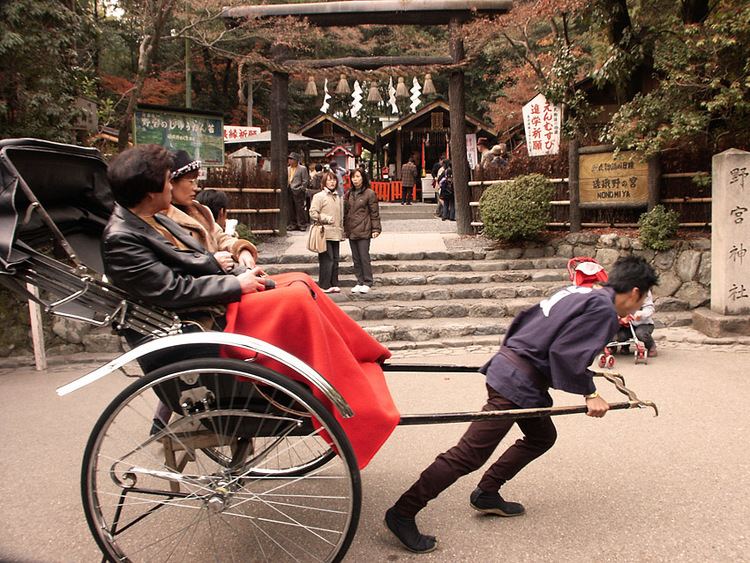 | ||
Japan attracted 19.73 million international tourists in 2015. Japan has 19 World Heritage Sites, including Himeji Castle, Historic Monuments of Ancient Kyoto and Nara. Popular foreigner attractions include Tokyo and Hiroshima, Mount Fuji, ski resorts such as Niseko in Hokkaido, Okinawa, riding the shinkansen and taking advantage of Japan's hotel and hotspring network.
Contents
- Map of Japan
- History
- Statistics
- Tourism today
- Hokkaido
- Thoku region
- Kant region
- Chbu region
- Kansai region
- Chgoku region
- Shikoku
- Kyushu and Okinawa
- Tourism after the Fukushima disaster
- References
Map of Japan
The Travel and Tourism Competitiveness Report 2015 ranks Japan 9th out of 141 countries overall, which was the best in Asia. Japan gained relatively high scores in almost all aspects, especially health and hygiene, safety and security, cultural resources and business travel.
History
The origins of early traditions of visits to picturesque sites are unclear, but early sight-seeing excursions was Matsuo Basho's 1689 trip to the then "far north" of Japan, which occurred not long after Hayashi Razan categorized the Three Views of Japan in 1643. During the Edo era of Japan, from around 1600 to the Meiji Restoration in 1867, travel was regulated within the country through the use of shukuba or post stations, towns where travelers had to present appropriate documentation. Despite these restrictions, porter stations and horse stables, as well as places for lodging and food were available on well-traveled routes. During this time, Japan was a closed country to foreigners, so no foreign tourism existed in Japan.
Following the Meiji Restoration and the building of a national railroad network, tourism became more of an affordable prospect for domestic citizens and visitors from foreign countries could enter Japan legally. As early as 1887, government officials recognized the need for an organized system of attracting foreign tourists; the Kihinkai (貴賓会), which aimed to coordinate the players in tourism, was established that year with Prime Minister Ito Hirobumi's blessing. Its early leaders included Shibusawa Eiichi and Ekida Takashi. Another major milestone in the development of the tourism industry in Japan was the 1907 passage of the Hotel Development Law, as a result of which the Railways Ministry began to construct publicly owned hotels throughout Japan.
Statistics
In 2016, 24,039,000 foreign tourists visited Japan.
Tourism today
Domestic tourism remains a vital part of the Japanese economy and Japanese culture. Children in many middle schools see the highlight of their years as a visit to Tokyo Disneyland or perhaps Tokyo Tower, and many high school students often visit Okinawa or Hokkaido. The extensive rail network together with domestic flights sometimes in planes with modifications to favor the relatively short distances involved in intra-Japan travel allows efficient and speedy transport.
In inbound tourism, Japan was ranked 28th in the world in 2007. In 2009, the Yomiuri Shimbun published a modern list of famous sights under the name Heisei Hyakkei (the Hundred Views of the Heisei period).
Neighbouring South Korea is Japan's most important source of foreign tourists. In 2010, the 2.4 million arrivals made up 27% of the tourists visiting Japan.
Chinese travelers are the highest spenders in Japan by country, spending an estimated 196.4 billion yen (US$2.4 billion) in 2011, or almost a quarter of total expenditure by foreign visitors, according to data from the Japan Tourism Agency.
The Japanese government hopes to receive 40 million foreign tourists every year by 2020.
Hokkaido
Tōhoku region
Kantō region
Chūbu region
Kansai region
Chūgoku region
Shikoku
Kyushu and Okinawa
Tourism after the Fukushima disaster
After the triple melt-down of the nuclear reactors in Fukushima, the number of foreign visitors declined for months. In September 2011 some 539,000 foreign people visited Japan, this was 25 percent down compared with the same month in 2010. This decline was largely attributed to the Fukushima nuclear accident and the stronger yen made a visit to Japan more expensive.
To boost tourism the Japanese Tourism Agency announced in October 2011 a plan to give 10,000 round-trip air tickets to Japan to encourage visitors to come. In 2012 free tickets would be offered if the winners would write online about their experiences in Japan. They also would need to answer some questions about how they felt while visiting Japan after the earthquake and how the interest in tourism in Japan could be renewed. About US$15 million would be spent on this program. On December 26, 2011, The Japan Tourism Agency reported on their site that the "Fly to Japan! Project", which would have given out 10,000 round-trip tickets to Japan, was not approved by the government for fiscal year 2012.
